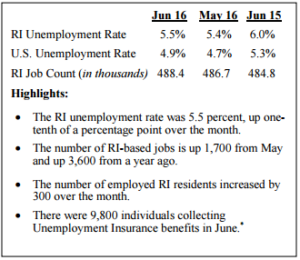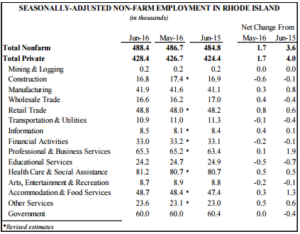Rhode Island-Based Jobs Up 1,700 from May; June Unemployment Rate Rises to 5.5 Percent
RISBJ Staff | Jul 27, 2016
CRANSTON, RI – The RI Department of Labor and Training announced today that the state’s seasonally adjusted unemployment rate for June 2016 was 5.5 percent, up one-tenth of a percentage point from the May rate. Over the year, the unemployment rate is down half of a percentage point from the June 2015 rate.
The U.S. unemployment rate was 4.9 percent in June 2016, up two-tenths of a percentage point from the previous month but down four-tenths of a percentage point over the year.
The number of unemployed RI residents—those residents classified as available for and actively seeking employment— was 30,200, up 400 from the May figure of 29,800. Over the year, the number of unemployed dropped by 3,300.
A total of 9,800 individuals collected Unemployment Insurance (UI) benefits in June 2016, * up from 9,074 a year ago. This month, UI claimants accounted for 34.3 percent of the total unemployed.
The number of employed RI residents was 523,100, up 300 from the May figure of 522,800. Over the year, the number of employed RI residents was up 600 from June 2015.
The RI labor force totaled 553,300 in June 2016, up 800 from May 2016 but down 2,700 from June 2015.
JOBS BASED IN RHODE ISLAND: Estimated nonfarm payroll in Rhode Island totaled 488,400 in June, reflecting a gain of 1,700 jobs from the May estimate of 486,700. The June job’s report ended two consecutive months of job declines which consumed 3,900 jobs. In all, the state is down 100 jobs through the half-way point of 2016, while being up 3,600 jobs from June 2015.
Retail Trade added 800 jobs in June, pushing the employment level to 48,800, the highest level since October 2008 (49,000). Retail Trade employment is up 600 over the year.
Employment in Health Care & Social Assistance grew by 500 in June, fueled by job gains reported in social assistance. Health Care & Social Assistance averaged a gain of 200 jobs in each of the past three months. Employment within this sector is up 500 from a year ago. A gain of 500 jobs was also reported in the Other Services sector, propelling its employment level to 23,600, the highest level since March 2005. The Other Services sector added 600 jobs over the year.
The Information and Wholesale Trade sectors each added 400 jobs in June. The increase in Information is largely due, in part, to the return of workers from a telecommunications strike, while widespread employment growth was reported amongst the Wholesale Trade sector.
The Manufacturing sector reported a gain of 300 jobs in June, regaining half of the 600 jobs lost in May. Manufacturing employment is up 800 from a year ago. The Accommodation & Food Services sector also added 300 jobs since May. This sector averaged a gain of 100 jobs during the first six months of the year and has 1,300 more workers now than a year ago.
Through the addition of 100 jobs in June, the Professional & Business Services sector reported positive job growth for four of the first six months this year, averaging a gain of 200 jobs per month. Employment within this sector is up 1,900 over the year.
Employment in Construction continued to trend down, shedding 600 jobs in June. This sector reported four consecutive months of job declines, totaling 2,000 jobs. Despite the recent downward trend, the number of jobs in the Construction sector is down just 100 over the year.
Educational Services employment fell by 500 over the month and is down 700 from a year ago.
Elsewhere, job declines were reported in the Arts, Entertainment & Recreation (-200), Financial Activities (-200) and Transportation & Utilities (-100) sectors, while employment remained unchanged in Government and Mining & Logging. MANUFACTURING: In June 2016, production workers in the Manufacturing sector earned $18.22 per hour, up twentyfive cents from May 2016, and up ninety cents from June 2015. Manufacturing employees worked an average of 39.0 hours per week in June, up nine-tenths of an hour from May and unchanged from a year ago.
METHODOLOGY: The unemployment figures are based largely on a survey of households in Rhode Island and measure the unemployment status of people who live in the state. Unemployment rates prior to 1976 are not recognized by the U.S. Bureau of Labor Statistics as official since the methodology used at that time is not comparable to today’s methods. The establishment of employment figures is derived from a survey of businesses in Rhode Island and measure the number of jobs in the state. Rhode Island labor market information is available at www.dlt.ri.gov/lmi. Additional information on procedures for producing Current Employment Statistics (CES) estimates is available on the BLS web site at www.bls.gov/sae/cesprocs.htm. BLS will be releasing all states’ June labor force data and job counts on July 22, 2016. DLT is scheduled to release the July 2016 labor force figures and job counts on Thursday, August 18, 2016, at 2:00 p.m.
ABOUT DLT: The RI Department of Labor and Training offers employment services, educational services and economic opportunities to both individuals and employers. DLT protects Rhode Island’s workforce by enforcing labor laws, prevailing wage rates and workplace health and safety standards. The department also provides temporary income support to unemployed and temporarily disabled workers. For more information, please call the RI Department of Labor and Training at (401) 462-8000 or visit the web site at www.dlt.ri.gov.
* Refers to the number of new and reopened claims filed by UI beneficiaries and claims filed by those already collecting UI in the week that includes the 12th of the month.
Leave a comment
About the Author: The Rhode Island Small Business Journal is a printed monthly magazine and an online resource for the aspiring and start-up entrepreneur and small business owner.












